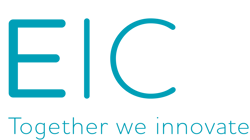Accessing Innovation from SME's - Q&A with the EIC and 1Spatial


Karen Jones, Account Manager in the Utilities team at 1Spatial recently caught up with David Turner-Bennet, Innovation Engineer at the EIC and Jessica Hampton, Head of Utilities at 1Spatial to discuss the importance and benefits of collaboration within the Utilities sector.
Name: David Turner-Bennett
Role: Innovation Engineer
Overview: Established in 2008, the EIC is a not-for-profit organisation created by seven utility partners (Wales & West Utilities, Cadent, Northern Gas Networks, Northern PowerGrid, SP Energy Networks, UK Power Networks and Scottish and Southern Electricity Networks). Working with 7000+ innovators from around the globe, the EIC exists to secure a safe, affordable net zero future that improves the quality of people’s lives.
The EIC operates a shared platform and open environment for utility partners and the community to innovate together.
There are three main functions of the EIC:
- A platform to bring utilities and innovators together
- A process to take projects from idea to business as usual
- A team of technical and commercial experts to make the journey happen
Tagline: Working together to achieve a safe, affordable, net zero future for all.
Name: Jess Hampton
Role: Head of Utilities
Overview: 1Spatial is a global leader in providing software, solutions and business applications for managing location and geospatial data. 1Spatial is striving to make the world safer, smarter and more sustainable for the future and believe the answers to achieving these goals are held in data.
1Spatial is passionate about working with our customers, to unlock the value of location data. The business environment is changing faster than ever. National goals of secure, sustainable and affordable energy are driving innovation in the energy sector, 1Spatial leverages its experience of the largest geospatial databases on earth to simplify and automate workflows for data creation, management and analysis.
The result is more efficient processes that enable the network enterprise to handle much larger volumes of data, more quickly, with greater accuracy and at lower cost than ever before.
Tagline: Unlocking the value of location data
Q: What is most beneficial about working with SMEs?
A:
David: SMEs are known to be the life blood of innovation creating circa 75% of innovative ideas and solutions within the UK. That is why it is so important for the energy industry, given the net zero challenge, to effectively engage with all innovators as the challenge ahead requires all businesses and innovators to align and work together to meet the climate emergency.
We collaborate with a wide variety of small businesses that bring diverse, disruptive yet beneficial solutions to our partners. I’ve witnessed time and time again fantastic ideas with great impacts come from SMEs.
Small businesses think differently, are more agile and can bring forward solutions that big businesses may not have the resources, focus or creativity to deliver.
Q: What value does working with SMEs have for the EIC?
A:
David: The EIC exists to facilitate innovation, that being said, without our SME community there wouldn’t be much innovation!
We place great value on giving innovators in our industry the opportunity to be heard, as we know they can make a positive difference. A steering group of 20 SMEs from the EIC’s Innovation Community was formed to create the Innovator Impact Panel. Working with these SMEs has been extremely valuable as the panel has had a huge influence OFGEM’s approach to RIIO-2. The Panel also played a vital role in reviewing the EIC’s business plan for 2020/21 ensuring we continue to deliver valued services and an effective plan that rises to new challenges.
Q: What is the most challenging aspect of bringing together utilities to collaborate?
A:
David: Any collaboration brings an increased level of risk and increase in the time it takes to progress an innovation project. Given we work across many networks, what is important to one business may not be as important to another, which impacts upon how they prioritise their workloads. The cultures of the businesses are often different as is their risk appetites, all of which can impact on the broader collaboration.
However, this is the EIC’s core purpose and over the many years we have developed ways of managing these challenges to minimise the impact on innovators as far as possible.
We continue to work tirelessly with innovators, government bodies, the industry regulator and our utility partners to support collaboration on all levels, to achieve net zero targets. In recent years, our partners have turned a corner and are now open to collaboration more than ever to drive the ambitions of future decarbonisation.
Jess: I typically see three main challenges in bringing together multiple utilities to collaborate:
- 1 Requirements – Understandably each utility wants a solution built to their own requirements. Working with the EIC, collaborators usually find a compromise when it comes to business processes and the functionality of the solution. However, sometimes the underlying technology that the solution will need to integrate with can be a blocker. Working with companies and technologies that are agnostic avoids this complication.
- 2 Time – Utilities are 24/7 service providers, meaning the teams are incredibly busy. As a result, co-ordination of key stakeholders can be difficult – this is one of the huge advantages of working with the EIC.
- 3 Competition – Innovation funding provided by regulators is reflective of the intention to encourage innovation and collaboration in the industry. However, this is a difficult balance for utilities, as at the same time the regulators create competition by comparing performance of the utilities with financial implications.
Q: Has the EIC facilitated innovation in a way that wouldn’t have been achievable otherwise?
A:
David: The EIC has de-risked innovating with smaller businesses for the larger companies and vice versa. We have spent 11 years listening to both innovators and the energy networks and are constantly adapting what we do based on the feedback from both parties to smooth the path of collaborating in innovation.
Jess: Yes, 1Spatial provides innovative technology that can be used to solve various business challenges. By collaborating with utilities and putting out Calls for Innovation, the EIC provides SME’s with defined business problems to build targeted solutions around. A great example of this is the award-winning Smart Signage Lighting and Guarding project 1Spatial delivered in collaboration with EIC and Northern Gas Networks. Prior to this EIC Call for Innovation, 1Spatial had not entered the street works domain - now we believe we have an industry-changing solution.
Q: What are the main drivers behind the collaborative approach between the EIC and utilities companies?
A:
David: The main driver for the EIC is that it is the right thing to do. Many would have heard of the philosophy of “a problem shared is a problem halved”. Networks need an innovation community to resolve challenges that will enable them to move more quickly toward a net zero world.
The more partners that are able to collaborate on a particular issue the better, as it allows sharing of resources, deeper understanding of the problem, wider buy in to facilitate deployment and a diverse project team to deliver a solution.
Q: Is there an eagerness to share best practice amongst utilities?
A:
David: There is now an eagerness to do this, but it has taken time. The networks are private businesses and competing with each other has been part of their DNA. However, in recent years, as each company’s innovation approach has matured, great sharing of best practice has ensued. It is now an expectation that networks share best practice and collaborate together, which in turn will deliver better value for money to customers.
Jess: In my experience, this varies from business to business, project to project and project lead to project lead. The requirement to disseminate information in order to receive Innovation funding is really positive in my opinion. More and more sharing of information is inevitable in the utilities industry. Only by sharing information does the bar for ‘innovation’ continue to rise, enabling the industry to benefit from revolutionary efficiencies. As utilities move towards a whole or connected systems approach, sharing of best practice, information and data will all become common place.
Q: What is the secret to success which has led to delivering 85% of the calls to innovation?
A:
David: Through our 130+ calls for innovation we’ve launched to date, the key has been having the right people involved from the beginning. Over a decade of listening to both colleagues in the energy sector and innovator community and continually iterating our approach has resulted in a very successful calls process. However, we will never take this for granted and continue to listen and learn from the world around us to continually see how we might do things better.
Jess: The key to all successful project deliveries is to involve the end-users in the design, build and roll-out of a solution. This ensures any cultural change required occurs more smoothly and end-users have the chance to provide feedback throughout the design and build. After all, if the end-users won’t use it, what’s the point? This approach results in the ultimate acceptance of the solution across the business becoming almost seamless. An added bonus is that it results in a fantastic working atmosphere whilst delivering the projects too!
Q: Is it the nature of the highly regulated utilities industry which has led to the high success rate in innovation from the EIC?
A:
David: The success of innovation is a constant effort by all involved such as our utility partners, SME community, the EIC and the relationships we work to build.
To find out more out innovation, please contact us or you can find us within the EIC Innovation Zone at this years' Utility Week Live.

